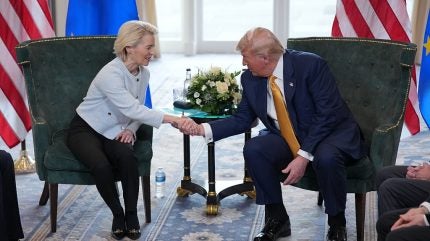
The much-awaited EU-US trade deal has landed. While it provides some much-needed respite for businesses that have been weathering seemingly never-ending economic uncertainty since US President Donald Trump’s tariffs began, the deal is being interpreted by many as a major win for the US and as a capitulation by Brussels.
“It is a dark day when an alliance of free peoples, brought together to affirm their common values and to defend their common interests, resigns itself to submission,” French Prime Minister François Bayrou said on a social media post.

Discover B2B Marketing That Performs
Combine business intelligence and editorial excellence to reach engaged professionals across 36 leading media platforms.
The EU has accepted a 15% tariff on most of its exports to the US, a more than 10% increase from the current average rate of 4.8%. US exports to the EU will face zero tariffs.
Sectors and investment pledges
The new tariff rate will affect around 70% of EU exports to the US, according to El País. The auto sector, crucial to Germany, will see its tariffs reduced from 27.5% to a 15% baseline. This reflects the rate that Japan secured for its automakers as part of its deal with the US, announced last week.
The list of remaining EU goods that will not be subject to the 15% rate is still being negotiated but is likely to include products and components that are central to meeting US domestic demand and furthering strategic goals. On Sunday (27 July), EU Commission President Ursula von der Leyen said this list would include aircraft and aircraft components, some agricultural products, certain chemical products, critical raw materials, natural resources and semiconductors.
While there was some initial confusion over whether it was included, the pharmaceutical sector will also face a 15% tariff, which could increase industry costs by $13bn to $19bn annually.

US Tariffs are shifting - will you react or anticipate?
Don’t let policy changes catch you off guard. Stay proactive with real-time data and expert analysis.
By GlobalDataThe EU also committed to purchasing €750bn ($865bn) worth of US natural gas, oil and nuclear technology during the remaining three years of Trump’s term, which would represent an annual spend of €250bn.
Leaders also agreed that European companies would invest €600bn into the US, although no time horizon or plan was provided for this. The figure comes from discussions between EU member states and European executives regarding the latter’s investment strategies.
EU pledges are ‘theatrics’
Davide Oneglio, director of European and global macroeconomics at TS Lombard, calls the deal “a bad one in absolute terms, an OK one relative to other countries”. However, regarding the foreign direct investment (FDI) and energy pledges from the EU, Oneglio says they are “theatre and not legally binding”.
“As [TS Lombard] anticipated since April, the EU’s strategy is ‘over-promising and under-delivering’, in line with its own experience during Trump 1.0 and China’s ‘phase 1 deal’. Unsurprisingly, Trump is already portraying such promises as ‘wins’, but nothing is legally binding,” Oneglia outlines.
“The huge €750bn figure cited in connection with energy imports (over three years) is meaningless, as it is unachievable not only because EU demand cannot grow that much but also because US exporters cannot supply that much either,” he says.
While there are no further details on the €600bn FDI deal, Oneglia adds that “as the EU is not China and cannot direct the private sector, that figure is meaningless too, with the EU already calling it an ‘intention’ and ‘no guarantee’.”
TS Lombard’s chief US economist Steven Blitz says: “Europe only accepts 15% because it knows it is doing the same to the US either through specific tariffs or non-tariff barriers.
“Lastly, the 15% is unlikely to change much other than being a source of revenue for the US Government, which is one of the main objectives. Slowly shifting from an income tax to a consumption tax to fund the government,” he adds.
Navigate the shifting tariff landscape with real-time data and market-leading analysis. Request a free demo for GlobalData’s Strategic Intelligence here.





